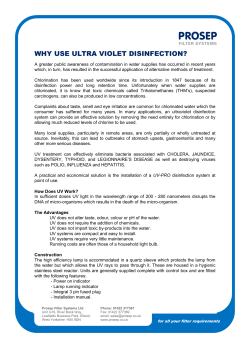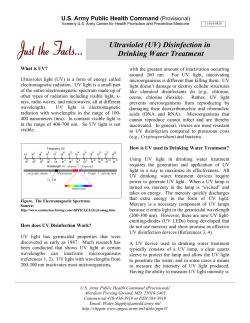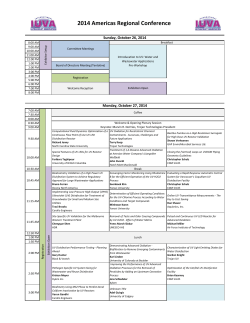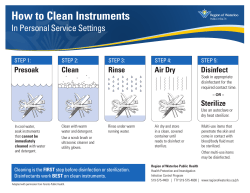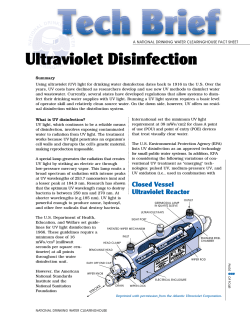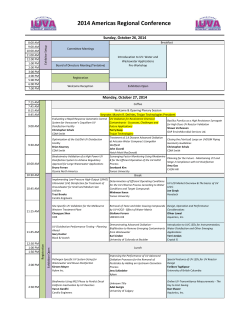
NOTES Water Treatment 10 Ultraviolet Radiation for Disinfecting Household Drinking Water
10 Water Treatment NOTES Cornell Cooperative Extension, College of Human Ecology Ultraviolet Radiation for Disinfecting Household Drinking Water LINDA WAGENET, SUSAN DARLING, AND ANN LEMLEY Fact Sheet 10, December 1993, updated August 2004 Ultraviolet (UV) rays are part of the light that comes from the sun. The UV spectrum is higher in frequency than visible light and lower than x-rays. As a water treatment technique, UV is known to be an effective disinfectant due to its strong germicidal (inactivating) ability. UV disinfects water containing bacteria, viruses, and Giardia lamblia and Cryptosporidium cysts. UV has been used commercially for many years in the pharmaceutical, cosmetic, beverage, and electronics industries. It was used for drinking water disinfection in the early 1900s but was abandoned due to high operating costs, unreliable equipment, and the expanding popularity of disinfection by chlorination. Recently, the safety of chlorination has been questioned and UV has experienced increased acceptance in both municipal and household systems. There are few large-scale UV water treatment plants in the United States although there are several such plants in Europe. Municipal systems use UV in conjunction with chlorine, thus reducing the amount of chlorine necessary for disinfection. Likewise, disinfection byproducts (DBPs), the chemicals associated with chlorination, are also reduced. Certain DBPs, such as trihalomethanes, have been linked to increases in certain cancers. UV treatment’s main advantage is that no chemical input is required. However, UV treatment lacks residual (remaining) disinfection in the water delivery system, such as that available with a chemical treatment system like chlorination. Therefore, a secondary disinfection method, such as chlorine or ozone may be a requirement for a UV system. Uses of UV disinfection UV radiation has disinfection properties that inactivate bacteria, viruses, and some other microorganisms. It effectively treats Giardia lamblia and Cryptosporidium cysts, which may also be removed from water by filtration. UV is not recommended if the untreated water contains very high levels of coliform, the indicator organism that is the basis for bacteriological water tests, or if there is substantial color or turbidity (cloudiness) in the water. UV is effective only if the light intensity reaches the organism in question; therefore, nothing should be present in the water that shields the organism from the radiation. Household UV treatment could conceivably be used for chlorinated water from a public supply if the home has a treatment device, such as an activated carbon filter, that removes chlorine (and thus allows bacterial growth). In this case, UV provides a final disinfection of the water supply. Principles of UV disinfection UV radiation has three wavelength zones: UV-A, UV-B, and UV-C, and it is this last region, the shortwave UV-C, that has germicidal properties for disinfection. A low-pressure mercury lamp resembling a fluorescent lamp produces the UV light in the range of 254 nanometers (nm). A nm is one billionth of a meter (10-9 meter). Since most microorganisms are affected by radiation around 260 nm, UV radiation is in the appropriate range for germicidal activity. There are UV lamps that produce radiation in the range of 185 nm that are effective on microorganisms and will also reduce the total organic carbon (TOC) content of the water. Either sediment filtration or activated carbon filtration should take place before water passes through the unit. Particulate matter, color, and turbidity affect the transmission of light to the microorganisms and must be removed for successful disinfection. UV is often the last device in a treatment train (a series of treatment devices), following reverse osmosis, water softening, or filtration. The UV unit should be located as close as possible to the point-of-use since any part of the plumbing system could be contaminated with bacteria. It is recommended that the entire plumbing system be disinfected with chlorine prior to initial use of a UV system. In a typical UV system, approximately 95 percent of the radiation passes through a special quartz glass sleeve and into the untreated water that flows in a thin film over the lamp. The glass sleeve keeps the lamp at an ideal temperature of 104 °F. UV radiation affects microorganisms by altering the DNA in the cells and impeding reproduction. UV treatment does not remove organisms from the water, it merely inactivates them. The effectiveness of this process is related to exposure time and lamp intensity as well as general water quality parameters. The exposure time is reported as "milliJoules per square centimeter" (mJ/ cm2), and the U.S. Department of Health and Human Services has established a minimum exposure of 16 mJ/cm2 for UV disinfection systems. Most manufacturers provide a lamp intensity of 30-50 mJ/cm2. Coliform bacteria, for example, are destroyed at 7 mJ/ cm2. Since lamp intensity decreases over time with use, lamp replacement is a key maintenance consideration with UV disinfection. In addition, UV systems should be equipped with a warning device to alert the owner when lamp intensity falls below the germicidal range. Used alone, UV radiation does not improve the taste, odor, or clarity of water. UV light is a very effective disinfectant, although the disinfection can only occur inside the unit. There is no residual disinfection in the water to inactivate bacteria percentage of microorganisms destroyed depends on the intensity of the UV light and the contact time. If material builds up on the glass sleeve, the light intensity and the effectiveness of treatment are reduced. Types of UV disinfection devices The typical UV treatment device consists, of a cylindrical chamber housing the UV bulb along its central axis (Fig. 1). A quartz glass sleeve encases the bulb; water flow is parallel to the bulb, which requires electrical power. A flow control device prevents the water from passing too quickly past the bulb, assuring appropriate radiation contact time with the flowing water. It has been reported that turbulent (agitated) water flow provides more complete exposure of the organism to UV radiation. A UV system housing should be made of stainless steel to protect any electronic parts from corrosion. To assure they will be contaminant-free, all welds in the system should be plasma-fused and purged with argon gas. The major differences in UV treatment units are in capacity and optional features. Some are equipped with UV emission detectors that warn the user when the unit needs cleaning or when the light source is failing. This feature is extremely important to assurance of a safe water supply. A detector that emits a sound or shuts off the water flow is preferable to a warning light, especially if the system might be located where a warning light would not be noticed immediately. NSF International, a nonprofit standard-setting organization, has developed standards for these UV light systems. NSF-approved systems can be found on the NSF website at www.nsf.org. Figure 1. Cross section diagram of a typical UV disinfection unit 2 Maintenance of a UV system Capacity of UV disinfection systems Since UV radiation must reach the bacteria to inactivate them, the housing for the light source must be kept clean. Commercial products are available for rinsing the unit to remove any film on the light source. An overnight cleaning with a solution of 0.15 percent sodium hydrosulfite or citric acid effectively removes such films. Some units have wipers to aid the cleaning process. UV systems are designed for continuous operation and should be shut down only if treatment is not needed for several days. A few minutes for lamp warm-up is needed before the system is used again following shut-down. In addition, the plumbing system of the house should be thoroughly flushed following a period of no use. Whenever the system is serviced, the entire plumbing system should be disinfected with a chemical such as chlorine prior to relying on the UV system for disinfection. Because UV lights gradually lose effectiveness with use, the lamp should be cleaned on a regular basis and replaced at least once a year. It is not uncommon for a new lamp to lose 20 percent of its intensity within the first 100 hours of operation, although that level is maintained for the next several thousand hours. As stated previously, units equipped with properly calibrated UV emission detectors alert the owner when the light intensity falls below a certain level. The treated water should be monitored for coliform and heterotrophic bacteria on a monthly basis for at least the first 6 months of the device’s use. If these organisms are present in the treated water, the lamp intensity should be checked, and the entire plumbing system should be disinfected with a chemical such as chlorine. UV is an in-line, point-of-entry system that treats all the water used in the house. The capacities range from 0.5 gallons per minute (gpm) to several hundred gpm. Certain point-of-use devices (treating water from a single tap) may include UV as a final disinfection method, as when used with reverse osmosis, for example. (For more information on reverse osmosis systems, consult Water Treatment Notes No. 4, Reverse Osmosis Treatment of Drinking Water.) Since bacteria may be shielded by particles in the water, pretreatment to remove turbidity may be required. There is also a limit to the number of bacteria that can be treated. An upper limit for UV disinfection is 1,000 total coliforms/100 mL water or 100 fecal coliforms/100 mL. Special considerations Prefiltration is required to remove color, turbidity, and particles that shield microorganisms from the UV source. Water that contains high mineral levels can coat the lamp sleeve and reduce the treatment effectiveness. Therefore, pretreatment with a water softener or phosphate injection system may be necessary to prevent build-up of minerals on the lamp. Table 1 lists the maximum levels of certain contaminants that are allowable for effective UV treatment. It is extremely important to remember that UV provides no residual disinfection of the water. Microorganisms that have been shielded from the UV light by components such as particulate matter or color, may not be completely exposed to the radiation and may be reactivated if they come in contact with oxygen. Therefore, storing UV-treated water for any period of time could result in recontamination. Quick Facts about UV Water Treatment • UV disinfection does not add chemicals to the water • UV is effective against bacteria, viruses, Giardia lamblia and Cryptosporidium UV disinfection has no residual disinfection Minimum lamp exposure of 16 mJ/cm2 UV often last device in a treatment train of water treatment devices UV device should have audible UV emission detector to notify user when lamp intensity is inadequate Regular maintenance and lamp replacement is essential • • • • • Table 1. Recommended maximum contaminant levels in water entering a UV treatment device. Turbidity 5 NTU* Suspended solids 10 mg/L Color Iron Manganese pH None 0.3 mg/L 0.05 mg/L 6.5-9.5 *Nephelometric Turbidity Units Source: Voitle, Robert. Water Technology. Oct. 1992. 3 UV water treatment is an effective way to disinfect home drinking water supplies; it is becoming increasingly popular as an alternative to chlorine disinfection systems because it adds no chemicals to the water. There are, however, specific water quality parameters that must be met for the UV system to produce adequate amounts of bacteriological safe water. In addition, adherence to a regular maintenance routine is essential. The authors: Linda Wagenet is a former water specialist in the NYS Water Resources Institute at Cornell University. Susan Darling is a former extension associate and Ann Lemley is a professor and chair in the Department of Textiles and Apparel, College of Human Ecology, Ithaca NY. Selected References Anderson, Ellis. UV disinfection for POU/POE applications. Water Technology. Oct. 1990. Pp. 46-52. Foust, H.C. How to treat drinking water with UV light. Water Technology. Feb. 1990. Pp. 28-31. Kendzel, James. UV getting NSF standard. Water Technology. Nov. 1990. Pp. 70-73. New Jersey Dept. of Environ. Protection/Div. of Water Res. "Ultraviolet Irradiation." Sept. 1988. Powell, G.M., and R.D. Black. "Disinfection of Private Water Supplies", a fact sheet from the Kansas Cooperative Extension Service. Manhattan. Nov. 1987. Tobin, R.S., D.K. Smith, A. Horton, and V.C. Armstrong. Methods for testing the efficacy of ultraviolet light disinfection devices for drinking water. J of the Amer. Water Works Assoc. Sept. 1983. Pp. 481-484. Voitle, Robert. Ultraviolet for potable water systems. Water Technology. Oct. 1992. Pp. 24-29. Wagenet, L.P., K. Mancl, and M. Sailus. "Home Water Treatment Devices." Northeast Reg. Agr. Engr. Service (NRAES). In press. Wolfe, R.L. Ultraviolet disinfection of potable water. Env. Sci. and Tech. Vol. 24, No. 6:768-773. 1990. FACT SHEET 10 MARCH, 2004 This publication is issued to further Cooperative Extension work mandated by acts of Congress of May 8 and June 30, 1914. It was produced with the cooperation of the U.S. Department of Agriculture; Cornell Cooperative Extension; and the College of Agriculture and Life Sciences, the College of Human Ecology, and the College of Veterinary Medicine at Cornell University. Cornell Cooperative Extension provides equal program and employment opportunities. Helene R. Dillard, Director 329FS10 25/100 12/93 9M MS PVC30319 4
© Copyright 2025
